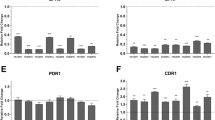Abstract
Candida albicans is the most important cause of systemic fungal infection in immunocompromised humans. Candidiasis is often initiated by the adherence and the colonization of inert surfaces such as peripheral venous catheters, central catheters, prosthetic cardiac valves, and other prostheses. We have studied the early stage of adherence and have shown that the disruption of C. albicans IFF4 gene encoding a GPI-anchor protein, led to a decrease of adherence of the germ tubes to plastic. Here, we demonstrated the role of the IFF4 gene in adherence to silicone catheter, as well as in virulence using a murine model of disseminated candidiasis. The iff4 Δ null mutant showed both a decrease of adherence to silicone catheter and a reduction of virulence. This work presents evidence for the importance of the IFF4 gene in host-fungal interaction.


Similar content being viewed by others
References
Pfaller MA, Diekema DJ, Jones RN, Sader HS, Fluit AC, Hollis RJ, et al. International surveillance of bloodstream infections due to Candida species: frequency of occurrence and in vitro susceptibilities to fluconazole, ravuconazole, and voriconazole of isolates collected from 1997 through 1999 in the SENTRY antimicrobial surveillance program. J Clin Microbiol. 2001;39:3254–9. doi:10.1128/JCM.39.9.3254-3259.2001.
Pfaller MA, Diekema DJ. Epidemiology of invasive candidiasis: a persistent public health problem. Clin Microbiol Rev. 2007;20:133–63. doi:10.1128/CMR.00029-06.
Pappas PG, Rex JH, Sobel JD, Filler SG, Dismukes WE, Walsh TJ, et al. Guidelines for treatment of candidiasis. Clin Infect Dis. 2004;38:161–89. doi:10.1086/380796.
Kojic EM, Darouiche RO. Candida infections of medical devices. Clin Microbiol Rev. 2004;17:255–67. doi:10.1128/CMR.17.2.255-267.2004.
Nett J, Andes D. Candida albicans biofilm development, modeling and host-pathogen interaction. Curr Opin Microbiol. 2006;9:340–5. doi:10.1016/j.mib.2006.06.007.
Verstrepen KJ, Klis FM. Flocculation, adhesion and biofilm formation in yeasts. Mol Microbiol. 2006;60:5–15. doi:10.1111/j.1365-2958.2006.05072.x.
Chaffin WL, Lopez-Ribot JL, Casanova M, Gozalbo D, Martinez JP. Cell wall and secreted proteins of Candida albicans: identification, function, and expression. Microbiol Mol Biol Rev. 1998;62:130–80.
Fukazawa Y, Kagaya K. Molecular bases of adherence of Candida albicans. J Med Vet Mycol. 1997;35:87–99. doi:10.1080/02681219780000971.
Klis FM, de Groot P, Hellingwerf K. Molecular organization of the cell wall of Candida albicans. Med Mycol. 2001;39(1):1–8.
Chaffin WL. Candida albicans cell wall proteins. Microbiol Mol Biol Rev 2008; 495–544. doi:10.1128/MMBR.00032-07.
De Groot PW, Hellingwerf KJ, Klis FM. Genome-wide identification of fungal GPI proteins. Yeast. 2003;20:781–96. doi:10.1002/yea.1007.
Martinez-Lopez R, Monteoliva L, Diez-Orejas R, Nombela C, Gil C. The GPI-anchored protein CaEcm33p is required for cell wall integrity, morphogenesis and virulence in Candida albicans. Microbiology. 2004;150:3341–54. doi:10.1099/mic.0.27320-0.
Sundstrom P. Adhesion in Candida spp. Cell Microbiol. 2002;4:461–9. doi:10.1046/j.1462-5822.2002.00206.x.
Plaine A, Walker L, Da Costa G, Mora-Montes HM, McKinnon A, Gow NAR, et al. Functional analysis of Candida albicans GPI-anchored proteins: roles in cell wall integrity and caspofungin sensitivity. Fungal Genet Biol. 2008;45:1404–14. doi:10.1016/j.fgb.2008.08.003.
Richard M, Plaine A. Comprehensive analysis of glycosylphosphatidylinositol-anchored proteins in Candida albicans. Eukaryot Cell. 2007;6:119–33. doi:10.1128/EC.00297-06.
Bates S, de la Rosa JM, MacCallum DM, Brown AJ, Gow NA, Odds FC. Candida albicans Iff11, a secreted protein required for cell wall structure and virulence. Infect Immun. 2007;75:2922–8. doi:10.1128/IAI.00102-07.
Kempf M, Apaire-Marchais V, Saulnier P, Licznar P, Lefrançois C, Robert R, et al. Disruption of Candida albicans IFF4 gene involves modifications of the cell electrical surface properties. Colloids Surf B: Biointerfaces. 2007;58:250–5. doi:10.1016/j.colsurfb.2007.03.017.
Andes D, Nett J, Oschel P, Albrecht R, Marchillo K, Pitula A. Development and characterization of an in vivo central venous catheter Candida albicans biofilm model. Infect Immun. 2004;72:6023–31. doi:10.1128/IAI.72.10.6023-6031.2004.
Tamura NK, Gasparetto A, Svidzinski TI. Evaluation of the adherence of Candida species to urinary catheters. Mycopathologia. 2003;156:269–72. doi:10.1023/B:MYCO.0000003559.59676.f7.
Richards MJ, Edwards JR, Culver DH, Gaynes RP. Nosocomial infections in medical intensive care units in the United States. National Nosocomial Infections Surveillance System. Crit Care Med. 1999;27:887–92. doi:10.1097/00003246-199905000-00020.
Wilson RB, Davis D, Mitchell AP. Rapid hypothesis testing with Candida albicans through gene disruption with short homology regions. J Bacteriol. 1999;181:1868–74.
Cutler JE. N-glycosylation of yeast, with emphasis on Candida albicans. Med Mycol. 2001;39(1):75–86.
Fu Y, Luo G, Spellberg BJ, Edwards JE Jr, Ibrahim AS. Gene overexpression/suppression analysis of candidate virulence factors of Candida. Eucaryot Cell. 2008;7:483–92. doi:10.1128/EC.00445-07.
Acknowledgments
The authors wish to thank Pierre Legras and Jerome Roux (Service Commun de l’Animalerie Hospitalo-Universitaire (SCAHU), Angers, France) for their technical assistance and Bruno Vielle and Patrick Saulnier (Université d’Angers, France) for their expert assistance. This work was supported by the University of Angers (France).
Author information
Authors and Affiliations
Corresponding author
Rights and permissions
About this article
Cite this article
Kempf, M., Cottin, J., Licznar, P. et al. Disruption of the GPI Protein-Encoding Gene IFF4 of Candida albicans Results in Decreased Adherence and Virulence. Mycopathologia 168, 73–77 (2009). https://doi.org/10.1007/s11046-009-9201-0
Received:
Accepted:
Published:
Issue Date:
DOI: https://doi.org/10.1007/s11046-009-9201-0




